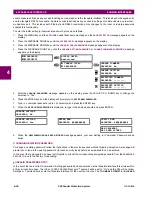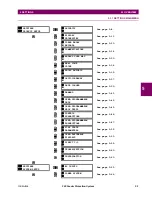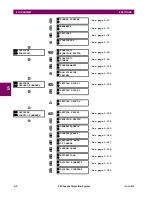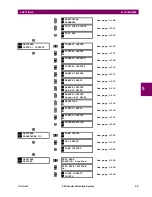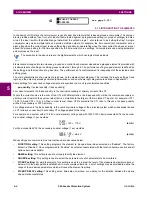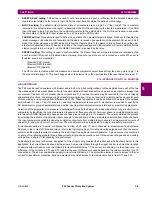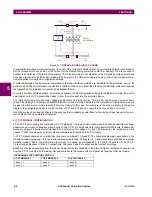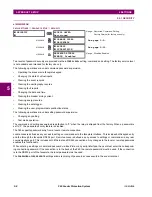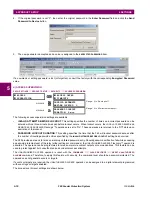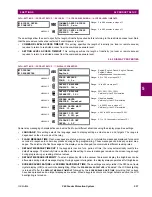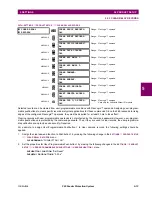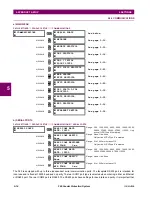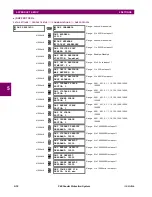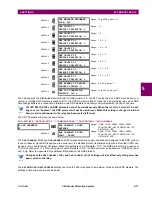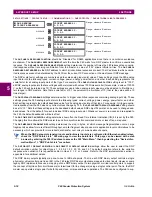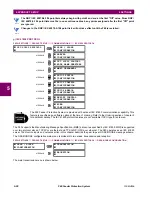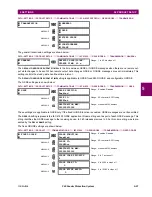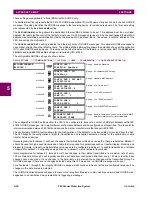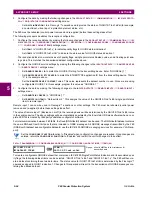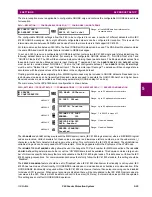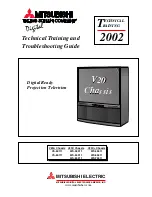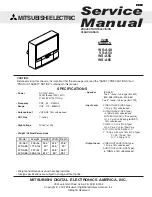
5-12
F60 Feeder Protection System
GE Multilin
5.2 PRODUCT SETUP
5 SETTINGS
5
•
CURRENT CUT-OFF LEVEL
: This setting modifies the current cut-off threshold. Very low currents (1 to 2% of the
rated value) are very susceptible to noise. Some customers prefer very low currents to display as zero, while others
prefer the current be displayed even when the value reflects noise rather than the actual signal. The F60 applies a cut-
off value to the magnitudes and angles of the measured currents. If the magnitude is below the cut-off level, it is substi-
tuted with zero. This applies to phase and ground current phasors as well as true RMS values and symmetrical compo-
nents. The cut-off operation applies to quantities used for metering, protection, and control, as well as those used by
communications protocols. Note that the cut-off level for the sensitive ground input is 10 times lower that the
CURRENT
CUT-OFF LEVEL
setting value. Raw current samples available via oscillography are not subject to cut-off.
•
VOLTAGE CUT-OFF LEVEL
: This setting modifies the voltage cut-off threshold. Very low secondary voltage measure-
ments (at the fractional volt level) can be affected by noise. Some customers prefer these low voltages to be displayed
as zero, while others prefer the voltage to be displayed even when the value reflects noise rather than the actual sig-
nal. The F60 applies a cut-off value to the magnitudes and angles of the measured voltages. If the magnitude is below
the cut-off level, it is substituted with zero. This operation applies to phase and auxiliary voltages, and symmetrical
components. The cut-off operation applies to quantities used for metering, protection, and control, as well as those
used by communications protocols. Raw samples of the voltages available via oscillography are not subject cut-off.
The
CURRENT CUT-OFF LEVEL
and the
VOLTAGE CUT-OFF LEVEL
are used to determine the metered power cut-off levels. The
power cut-off level is calculated as shown below. For Delta connections:
(EQ 5.3)
For Wye connections:
(EQ 5.4)
(EQ 5.5)
where VT primary = VT secondary
×
VT ratio and CT primary = CT secondary
×
CT ratio.
For example, given the following settings:
CURRENT CUT-OFF LEVEL
: “0.02 pu”
VOLTAGE CUT-OFF LEVEL
: “1.0 V”
PHASE CT PRIMARY
: “100 A”
PHASE VT SECONDARY
: “66.4 V”
PHASE VT RATIO
: “208.00 : 1"
PHASE VT CONNECTION
: “Delta”.
We have:
CT primary = “100 A”, and
VT primary =
PHASE VT SECONDARY
x
PHASE VT RATIO
= 66.4 V x 208 = 13811.2 V
The power cut-off is therefore:
power cut-off = (
CURRENT CUT-OFF LEVEL
×
VOLTAGE CUT-OFF LEVEL
×
CT primary
×
VT primary)/VT secondary
= (
×
0.02 pu
×
1.0 V
×
100 A
×
13811.2 V) / 66.4 V
= 720.5 watts
Any calculated power value below this cut-off will not be displayed. As well, the three-phase energy data will not accumu-
late if the total power from all three phases does not exceed the power cut-off.
Lower the
VOLTAGE CUT-OFF LEVEL
and
CURRENT CUT-OFF LEVEL
with care as the relay accepts lower signals
as valid measurements. Unless dictated otherwise by a specific application, the default settings of “0.02
pu” for
CURRENT CUT-OFF LEVEL
and “1.0 V” for
VOLTAGE CUT-OFF LEVEL
are recommended.
3-phase power cut-off
3
CURRENT CUT-OFF LEVEL
×
VOLTAGE CUT-OFF LEVEL
VT primary
×
CT primary
×
×
VT secondary
------------------------------------------------------------------------------------------------------------------------------------------------------------------------------------------------------------------------------
=
3-phase power cut-off
3
CURRENT CUT-OFF LEVEL
×
VOLTAGE CUT-OFF LEVEL
VT primary
×
CT primary
×
×
VT secondary
--------------------------------------------------------------------------------------------------------------------------------------------------------------------------------------------------------------------------
=
per-phase power cut-off
CURRENT CUT-OFF LEVEL
VOLTAGE CUT-OFF LEVEL
VT primary
×
CT primary
×
×
VT secondary
----------------------------------------------------------------------------------------------------------------------------------------------------------------------------------------------------------------
=
3
NOTE
Summary of Contents for F60 UR Series
Page 2: ......
Page 4: ......
Page 30: ...1 20 F60 Feeder Protection System GE Multilin 1 5 USING THE RELAY 1 GETTING STARTED 1 ...
Page 48: ...2 18 F60 Feeder Protection System GE Multilin 2 2 SPECIFICATIONS 2 PRODUCT DESCRIPTION 2 ...
Page 126: ...4 30 F60 Feeder Protection System GE Multilin 4 2 FACEPLATE INTERFACE 4 HUMAN INTERFACES 4 ...
Page 354: ...5 228 F60 Feeder Protection System GE Multilin 5 9 TESTING 5 SETTINGS 5 ...
Page 382: ...6 28 F60 Feeder Protection System GE Multilin 6 5 PRODUCT INFORMATION 6 ACTUAL VALUES 6 ...
Page 398: ...8 8 F60 Feeder Protection System GE Multilin 8 2 FAULT LOCATOR 8 THEORY OF OPERATION 8 ...
Page 414: ...A 14 F60 Feeder Protection System GE Multilin A 1 PARAMETER LIST APPENDIXA A ...
Page 492: ...B 78 F60 Feeder Protection System GE Multilin B 4 MEMORY MAPPING APPENDIXB B ...
Page 530: ...D 10 F60 Feeder Protection System GE Multilin D 1 IEC 60870 5 104 APPENDIXD D ...
Page 542: ...E 12 F60 Feeder Protection System GE Multilin E 2 DNP POINT LISTS APPENDIXE E ...
Page 558: ...x F60 Feeder Protection System GE Multilin INDEX ...

